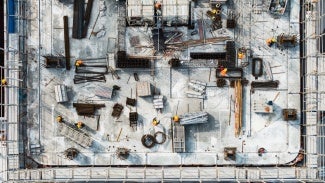
Better buildings begin with better materials
Uncovering the hidden human costs of material supply chains—and how architects can drive equity.
The fashion industry—more specifically, fast fashion—is coming under scrutiny.
While it’s cheap and convenient for consumers to buy new outfits from brands like SHEIN for almost any occasion, the underlying systems that make these purchases possible rely on the exploitation of workers across the supply chain and generate literal tons of extra waste every year. The clothes we wear play a role in how we are contributing—or addressing—both the climate and social justice crises.
There are close parallels between the fast fashion industry and the social and environmental justice impacts of building materials. While historically, materials were often chosen for aesthetics or durability, advocates are leading a movement in the building industry to take a critical eye to the materials we’re selecting and how they are contributing to a more healthy, sustainable, resilient, and equitable built environment.
The AIA Materials Pledge framework and mindful MATERIAL’s Common Materials Framework (CMF) align with five impact categories that comprise a holistic definition of responsible materials: Human health, social health and equity, climate health, ecosystem health, and a circular economy. Though distinct impact categories, there is intersection—and sometimes tension—amongst all five. Currently, no materials necessarily fit all five definitions of responsible materials—rather, there are tradeoffs between the five impact categories that designers need to weigh based on client and project team priorities.
Here, we explore one of the least-known impact categories to architects and designers, social health and equity, and lay out how to improve the use of ethically produced materials across the industry.
Social health and equity in the supply chain
The social health and equity impact of building materials doesn’t begin when they’re being utilized in construction or renovations. There is a whole life cycle of these products that contributes to their full scope of impact. Since there is no international body for regulation of labor standards and policies in the global supply chain, this information can be difficult to track.
Certain products from specific regions are known to be more at risk of utilizing either forced or child labor in their production. The Grace Farms Foundation’s Design for Freedom Toolkit dives deeply into 12 at-risk materials, including specific risks to be aware of, regions that are major exporters, and relevant certifications that can signify better social practices.
Social health and equity and its five counterpart impact categories all intersect when understanding the implications to frontline communities of extraction and manufacturing sites. This pertains to ethical sourcing from local communities and the direct human health impacts of industrial sites to frontline communities, often low-income and Black, Indigenous, and People of Color (BIPOC).
Social health and equity in the workplace
The consideration of social health and equity for materials selection also lies within the company workplace. Transparency within company policies and practices can signify companies that are more focused on corporate social responsibility and environmental and social governance. These best practices are typically third-party or self-reported labels like B Corp, the JUST label, Minority- and Women-owned business enterprises (MWBE) certification, or manufacturer affidavits about various social equity workplace programs and policies.
What can architects do to get started?
Social health and equity is a complex impact category, requiring scrutiny along the entire supply chain that often transcends international boundaries. Within AIA Materials Pledge signatories, it is reported as the impact category with the least information available and the one architects and designers are least knowledgeable about. The important first step is to simply begin to understand what the issue is. The following steps can outline where to begin:
- Establish firmwide education on the social impacts of materials. There are several external resources to share with project teams:
o The Freedom Fund’s Built on Repression
o Grace Farms Foundation’s Design for Freedom Toolkit
o UW CBE & ZGF’s Environmental and Social Justice in Building Materials: Who Bears the True Cost?
o COOKFox Architects’ Survey of Labor Certifications for the Built Environment
o BWBR’s Forced Labor in the Building Material Supply Chain Mitigation Framework - Start asking questions. Transparency is the first step, requiring architects to ask product manufacturers about human rights compliance along the product’s entire supply chain.
- Look for product manufacturers with certain labels and certifications. Company workplace labels or product certifications like Cradle to Cradle (C2C), Living Product Challenge, or Forest Stewardship Council (FSC) can signify better social health and equity practices.
There remains no product, project, or firm that is addressing social health and equity perfectly—rather, collective action and advocacy is the industry’s superpower to transforming materials into ones that can be better for people and the planet.
Eana Bacchiocchi is Climate Action Pledge Programs Manager at AIA.
